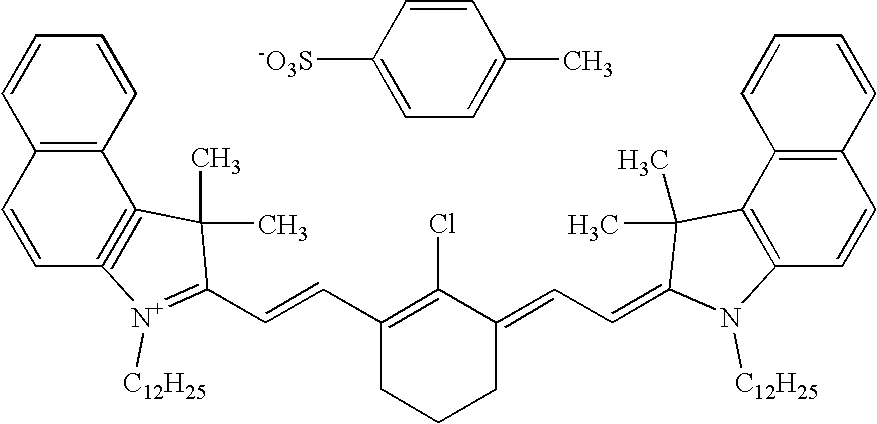On-press developable lithographic printing plate precursor
- Summary
- Abstract
- Description
- Claims
- Application Information
AI Technical Summary
Benefits of technology
Problems solved by technology
Method used
Image
Examples
example 1
[0129]A coating composition for image forming layer having the formulation shown below was applied to the aluminum support with a bar coater to a dry coating weight of 1.0 g / m2 and dried in an oven at 80° C. for 90 seconds to prepare a lithographic printing plate precursor.
Coating Composition for Image Forming Layer:
[0130]
Water100gMicrocapsules (1) (on a solid basis)5gAcid generator A-50.5gFluorine type surface active agent (Megafac F-171 fromDainippon Ink & Chemicals, Inc.)0.05g
[0131]The resulting printing plate precursor was imaged on a Creo Trendsetter 3244VX equipped with a water-cooled 40 W infrared semiconductor laser under conditions of an output power of 17 W, an external drum rotation speed of 150 rpm, an energy density of 200 mJ / cm2 at the image plane, and a resolution of 2400 dpi. The exposed area turned purple blue to form a printed-out image with a contrast enough to be distinguished from the unexposed area. The density difference between the exposed and unexposed areas...
example 2
[0133]A lithographic printing plate precursor was produced in the same manner as in Example 1, except for using the microcapsules (2) in place of the microcapsules (1). On imagewise exposure, the exposed area turned purple blue to form a printed-out image with a contrast enough to be distinguished from the unexposed area. The density difference between the exposed and unexposed areas was 0.35 measured with Gretag Macbeth D19C. On printing in the same manner as in Example 1, the plate precursor was developed on press and became capable of printing. Close observation of the 10th copy with a 20× magnifier revealed excellent density uniformity on the solid image area and no stains on the non-image area. Printing was continued to get more than 20,000 impressions without causing fine lines and text missing, density unevenness in a solid image area and scumming.
example 3
[0134]A lithographic printing plate precursor was produced in the same manner as in Example 1, except for using the microcapsules (3) in place of the microcapsules (1). On imagewise exposure, the exposed turned black to form a printed-out image with a contrast enough to be distinguished from the unexposed area. The density difference between the exposed and unexposed areas was 0.36 measured with Gretag Macbeth D19C. On printing in the same manner as in Example 1, the plate precursor was developed on press and became capable of printing. Close observation of the 10th copy with a 20× magnifier revealed excellent density uniformity on the solid image area and no stains on the non-image area. Printing was continued to get more than 20,000 impressions without causing fine lines and text missing, density unevenness in a solid image area, and scumming.
PUM
 Login to View More
Login to View More Abstract
Description
Claims
Application Information
 Login to View More
Login to View More - R&D
- Intellectual Property
- Life Sciences
- Materials
- Tech Scout
- Unparalleled Data Quality
- Higher Quality Content
- 60% Fewer Hallucinations
Browse by: Latest US Patents, China's latest patents, Technical Efficacy Thesaurus, Application Domain, Technology Topic, Popular Technical Reports.
© 2025 PatSnap. All rights reserved.Legal|Privacy policy|Modern Slavery Act Transparency Statement|Sitemap|About US| Contact US: help@patsnap.com



